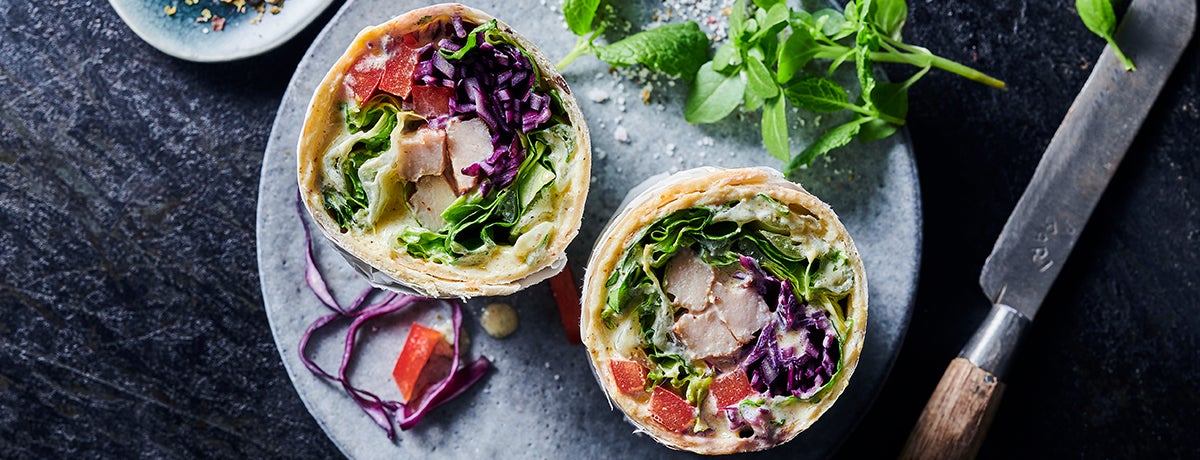Healthy Habits – Your path to a healthier lifestyle
 ©foodspring
©foodspring
Healthy habits make a healthy lifestyle a breeze. Find out how to form healthy habits and break bad ones, and why these good patterns are the key to better health and happiness.
Develop better health habits and share them with our community. No matter what your individual goal is, we’re here to help you to achieve it! Follow #mynewnormal to get lifestyle tips and inspiration. Be a part of it!
5:30 in the morning. The alarm clock rings. You jump out of bed, full of motivation to work out. Afterward you enjoy a Green Smoothie before starting a productive, energetic day. After your high-protein dinner with fresh vegetables and a short mindfulness meditation, you slumber peacefully for 8 hours before starting again tomorrow.
OK, that’s very ambitious. But forming at least a few better ways to improve our health can’t be that hard, can it? It’s okay. Turning negative patterns into positive ones can be easier said than done, but with a little effort, it can absolutely be done.
Before you start turning your life upside down, take a quick breath, and take the time to think about what you want. The key to developing healthy habits in your life is to recognize their power. To do this, you need to understand how they are created and how they work. Ready? Let’s go!
What are habits?
A habit is a behavior that is made second nature through constant repetition over a long period of time. It is applied to specific situations and triggered by external circumstances.
In other words: in specific recurring situations, you will automatically carry out a specific action or behavior. It doesn’t matter whether it’s automatically reaching for chocolate or a morning run while still half asleep. Everything you do regularly in recurring situations without thinking about it is a habit.
According to psychologist Bas Verplanken, 30-50% of our daily actions are habits. It’s actually pretty smart: programming these patterns saves the brain some neurological and cognitive resources. It’s a bit like running on battery-saver mode.
What are habits useful for?
Habits structure our lives and provide a sense of stability. They make everything easier: Something you do routinely because it’s part of your everyday life saves your body energy and time.
Imagine if you had to decide each and every day whether to shower, brush your teeth, or put one foot in front of the other! Unfortunately, though, there is a catch: the brain does not distinguish between the good ones and the bad ones.
Depending on which actions you have internalized, good or bad ones determine your life.
Once you have established healthier habits, you exercise and eat healthy foods without thinking about it, simply because it’s your routine. But whether you routinely choose fast food or avocado toast depends, in simple terms, on what your brain has neurologically recorded as “good.” Whether you’d consciously make the same assessment is another question.
Healthy habits make you happy because they are by definition in line with your personality and your self-image. Your behavior corresponds to your values, which creates a feeling of inner balance. You feel happier and more satisfied.
Bad ones have the opposite effect on your health. They create an internal inconsistency that you have to struggle with. In psychology, this state is known as cognitive dissonance.
How do habits develop?
Operating on autopilot. In his book Atomic Habits, James Clear argues that both good and bad habits are based on a neurological cycle5. According to Clear, habits are made up of 4 components:
The cue (trigger), the craving, the response (action), and the reward.
1. The Cue: Your alarm clock rings. The Cue stage triggers a certain, mostly unconscious, behavior. It can be related to space, emotions, time, mental state or an external factor.
2. The Craving: After eight hours of deep sleep, you want to get your blood pumping. You are already longing for the reward. Your craving is the motivation you need to start your activity. Often subconsciously it is an important drive of your actual habit.
3. The Action: You lace up your running shoes and have an easy jog around the block. The action is your habit. It can be an active behavior or a thought.
4. The Reward: A sumptuous breakfast after your run.
The reward creates a positive feeling, which is the foundation of the whole concept of habits.
These 4 components form what Clear calls a habit loop in our brain. The more often the complete four-step cycle takes place, the stronger the connection between the trigger and the action grows. Eventually your habits become so strongly rooted that you no longer notice the trigger, nor do you consciously think about your actions.
If you want to form new habits, it is important to understand and internalize this structure. Not only can you build positive habits; if you break this cycle, you can also avoid forming bad habits.
If you want to change your habits, the most crucial step is to identify the trigger and develop a desire (an internal motivation) for your new habit.
Here’s an example. We all know this one too well: that craving for chocolate after you finish lunch. Let’s imagine you want to stop reaching for the post-meal sweets from now on. Just telling yourself not to isn’t going to get you into a new habit in the long run.
Instead, we recommend that you focus on the trigger and your reward. From now on, for example, reward yourself with a rejuvenating walk in the fresh air instead of a sweet in a package. If you concentrate on the feeling of getting your body moving, it will be easier to react to the same trigger (finishing lunch) with a different action as time goes by. The more often you react in this way, the stronger your desire for the reward (the positive feeling of moving your body) will become and the more motivation you’ll generate. If you repeat this pattern often enough, your new behavior will become routine after a while. Until then, though, you’ll probably need some discipline.
Why is it so difficult to form healthy habits?
Because humans are programmed to stay in a comfort zone. It’s familiar, convenient, and safe. Why would your body want to change anything? This mechanism is complex. Researchers have found that they are programmed so tightly in the brain that you can’t just go against them with willpower. Instead, you have to reprogram everything deliberately. It takes time, patience, and discipline.
The top 10 healthy habits
That’s enough theory. Unfortunately, there’s not a universal formula with a satisfaction guarantee. But there are some behaviors that many people find rewarding for their health. Here are our top 10 healthy habits.
#1 Walk 7,500 – 15,000 steps a day.
Every day. Your exercise counts, as well. Pedometer Apps, Smartwatches or Fitness Trackers help you to track your movement. Physical activity in everyday life is beneficial for your physical health and helps you to unwind.
According to the WHO, 10,000 steps are equivalent to a good 30 minutes of exercise. Various studies show that even 7,500 steps could have positive health effects, while others suggest 15,000 steps. Find out what works for you.
#2 Work out three times a week.
With three workouts a week, you can work on your athletic goals and track your progress. This frequency also guarantees enough recovery time.
#3 Make healthy eating the default.
Ditch the fast food and make balanced, healthier foods your go-to. As soon as you have done so, sugar cravings and ravenous appetite attacks will be a thing of the past.
Tip: Here are 5 simple tricks to replace unhealthy foods with healthy foods. For every day, guaranteed.

#4 Drink enough water.
Easier said than done. How much water you should be drinking depends on activity levels, the season, nutrition, and other factors. A good guideline is 2-3 liters of water a day. Soft drinks don’t count! Need more ideas? Check out our top tips to drink more water.
#5 Relax daily.
Allow yourself some time off. You do not have to perform all day. Even small breaks in everyday life, a few conscious breaths, 30 minutes of exercise or a short power nap will help you to cope with high demands.
Daily relaxation will also reduce the negative physical effects associated with excessive stress levels. Definitely a plus for your health.
#6 Stick to your sleep routine.
Restful sleep is the foundation of your health. Not everyone needs 8 hours of sleep. Sleep scientist Nick Littlehales, the sleep coach of international competitive athletes, explains that sleep takes place in 90 minute cycles. Ideally, you should go through 4-6 of these per night.
#7 Meditate daily.
The beneficial effects of meditation have long since taken spiritual practice into the mainstream. CEOs, managers, and top athletes use meditation to better focus on their goals, productively deal with stress and their mental health, reflect on their beliefs, and go through life more calmly.
And those are just a few of the health benefits. You can also learn to meditate. Especially as a beginner a meditation app or guided meditations can be helpful.
#8 Establish a morning routine.
Mornings determine how the rest of your day will go. That’s why it is especially important to do something in the morning that will help you to feel good throughout the day and to master any upcoming challenges with confidence. Check out our 6 tips for a productive morning routine.
#9 Treat yourself to a little digital detox.
Time without a screen – including your phone and smartwatch – is soothing to the soul and better for your overall health. It brings you back to the moment and gives you the opportunity to be present. Choose a few minutes a day when you decide to switch everything off and consciously do something analog for yourself.
Whether this is meal prep, reading, painting, or crafting, or even just looking out the window is up to you.
#10 Stay positive.
This doesn’t mean that you should pretend that nothing has gone wrong. On the contrary, failures are part of life and can be felt and accepted. But being thankful for the small things helps you to focus on the good things in life.
Tip: To strengthen your focus, write down three things you were grateful for, or which were especially nice, every evening for three months.
Building healthy habits – 11 tips
In theory, this all sounds great. But putting it into practice might be a little more difficult. With these 11 tips for your health, you will gradually manage to learn the behavior you want for yourself. Your body will thank you.

#1 Single Tasking
Don’t try to change everything cold turkey. Choose one or at most two things that you want to develop and focus fully on them for three months.
The more complex an action is, the more difficult it is to make it routine. Exercising three times a week is already logistically more complex to integrate into everyday routine than drinking more water, not to mention the amount of motivation it requires.
Our Tip: Check out our 12 tips on how to motivate yourself to exercise if you just can’t get into the workout mindset!
#2 Go all in
Do not try to establish a healthy habit, simply do it. Language shapes thinking and perception. How you conceptualize something is crucial. You are not trying to eat a healthier diet from now on. You are eating healthier foods from now on. Period.
By the way, this also includes expressing these goals in positive ways. Don’t say what you no longer want to do, but rather phrase your goal clearly as what you do want. Not doing something is not a habit, strictly speaking.
#3 Set an anchor
A habit is always linked to a specific situation. Take advantage of this mechanism by deliberately anchoring yourself. Connect the habit you want to create with a situation that already exists in your everyday life.
If you want to drink more water, imagine drinking a glass of water every time you get your coffee. Play the same playlist every time you want to focus on your work or as you get ready for the gym.
#4 Check your environment
Your everyday situations must leave room for what you want to work on. Are there people, circumstances, or patterns that prevent you from doing so? Change it up in your favor so that you can do what you want to do.
#5 Be realistic
From couch potato to ultramarathoner? Sure, lots of people have done it. But then again, a lot of people haven’t. Pick something that you can implement and achieve immediately.
Is your long-term goal to lose 10 kilos and keep it off? The habit of eating fresh greens once a day will support you better than the doomed attempt to never eat chocolate again.
Integrating healthy eating into your everyday life is easier than you think. All you need is the discipline of standing in the kitchen and some quick recipes that suit your body, your life, and your goals. We can’t do the discipline part for you. But we can help you with the recipes.

#6 Intrinsic motivation: make it concrete
Define exactly which habit you want to establish. Health habits always have a decisive advantage: they are good for your health and body. Unfortunately, the term “healthy” is rather abstract, and that’s often not enough as a motivation.
Define exactly what you hope for from your new routine and why you want to establish it for your body. That could look like this, for example:
“I would like to go for a 15-minute walk after lunch every day because I’ll avoid a midday slump and be more productive in the afternoon. That will make me more successful at my job and more satisfied overall.”
Think back on this motivation every time it’s raining after lunch or you think you don’t have the 15 minutes for your walk.
#7 Reward yourself
Remember: A habit is created through the interaction of situation/trigger, action, and reward. That is, if you want to form your healthy habit, you must also reward yourself for the action that is to become a habit.
Choose a specific reward. The fact that at some point you will be 10 kilos lighter, heavier, or happier is a great motivation to stay on the ball. In the short term, however, that fact won’t help the reprogramming process that has to take place in your brain. To get this process going, the reward must be direct.
Sometimes the way your body feels after exercise is enough as a reward. If you cannot reward yourself immediately after every single action, think of your own reward system.
For example, you could tick off every daily salad you have eaten and reward yourself with a visit to your favorite restaurant after 10 salads. Documenting your actions in dedicated apps or habit trackers can also be a good reward and motivation.
#8 Discipline wins in the end
British researchers gave subjects the task of performing a healthy daily action (either in their eating, drinking, or exercise) for about three months to find out at what point this action becomes a habit.
After evaluation of the questionnaires, it was found that it took an average of 66 days for the respective activity to become routine and thus a habit. However, this is a mean value. Some respondents stated that they felt that their actions became routine much earlier, while others took much longer. Stick with it.
#9 ‘All or nothing’ means nothing
Yes, you have to be disciplined as best you can, so that the behavior will be fixed in your brain. But don’t throw the whole project to the wind just because you have failed for a day or a week. Grit your teeth and move on. No one said it would be easy. But: You can do it!
#10 Examine your beliefs
You’ve always been unathletic, which is why the half-marathon thing is not gonna happen. Is it? If you want to form a healthy habit, test your beliefs before you start working at it.
Do you have any beliefs that conflict with your new routine? Then ask yourself the following questions and answer them in writing:
- Where did this belief system come from and when did it emerge?
- What has this belief kept you from doing?
- In what ways would your life look different if you did not have this belief?
#11 Share your journey
A healthy amount of social pressure never hurts: Let the people around you know what you are up to. You might even find someone who has similar health goals as you and wants to encourage you. Exchange experiences, find like-minded people and friends, inspire others, and let yourself be inspired.
Change bad habits
It’s more difficult to change a bad habit than to establish a healthy one more or less from scratch. The most effective way to change a bad habit is to replace it with a good habit. It’s easier to do something else than to do nothing at all.
These steps can help you change them.
#1 Understand the bad habit you want to change. Where does it come from and why do you keep it up? What is the (supposed) reward? What would your life be like if you did not have this bad habit? Listen to yourself. Every bad habit has a reason – even if it’s only convenience.
#2 Identify the condition in which the bad habit breaks and link it to a new action. Apply the trigger-action-reward scheme here as well.
#3 Decide whether you can change the habit on your own or need help. The boundaries between addiction and habit are fluid, psychologically as well as physically. Is it a habit that you smoke a cigarette every time you wait for the train? Or is it addiction? If you feel that you cannot get rid of a bad habit that you really want to get rid of, seek professional help.
Summary
- Habits structure everyday life and offer a sense of stability.
- They form 30-50 % of our daily actions.
- Both healthy and bad habits are firmly programmed in the brain.
- A habit always develops in correlation with situations and rewards.
- Changing them requires discipline.
- Healthy routines that are in line with your values and your self-image make you happy in the long run.
Sources for this article
We at foodspring use only high-quality sources, including peer-reviewed studies, to support the facts within our articles. Read our editorial policy to learn more about how we fact-check and keep our content accurate, reliable, and trustworthy.
- Lally, P., van Jaarsveld, C.H.M., Potts, H.W.W. and Wardle, J: How are habits formed: Modelling habit formation in the real world. Eur. J. Soc. Psychol., 40: 998–1009. Published 2011. doi:10.1002/ejsp.674
- Littlehales, Nick: Sleep: The Myth of 8 Hours, the Power of Naps, and the New Plan to Recharge Your Body and Mind. Da Capo Lifelong Books, 2018.
- Neumeir, Christian: Stress bewältigen. Munich, 2010.
- Nilsen P, Roback K, Broström A, Ellström PE. Creatures of habit: accounting for the role of habit in implementation research on clinical behaviour change. Implement Sci. 2012;7:53. Published 2012 Jun 9. doi:10.1186/1748-5908-7-53.
- Tudor-Locke C, Craig CL, Brown WJ, et al.: How many steps/day are enough? For adults. Int J Behav Nutr Phys Act. 2011;8:79. Published 2011 Jul 28. doi:10.1186/1479-5868-8-79.
- W. W. Tigbe, M. H. Granat, N. Sattar, M. E. J. Lean: Time spent in sedentary posture is associated with waist circumference and cardiovascular risk. Int J Obes (Lond) 2017 Jan 31 Published online 2017 Jan 31. doi: 10.1038/ijo.2017.30
- Clear, James (2018). Atomic Habits. 2018. New York: Avery, an imprint of Penguin Random House.

































